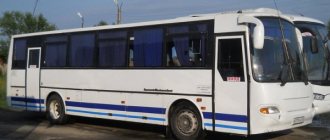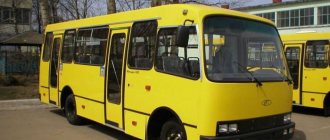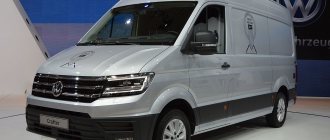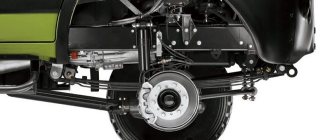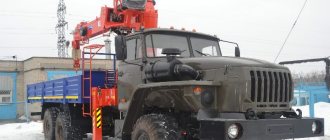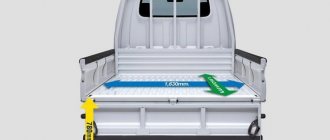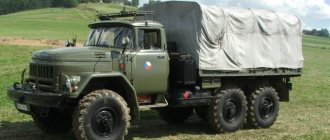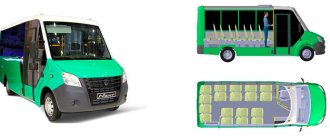Bus groove 32053: technical specifications, number of seats, photos
The school modification PAZ 32053-70 fully complies with GOST R 51160-98 “Buses for transporting children. Technical requirements". The buses are designed for 22 seats, incl. 2 for accompanying adults, and an additional step will help even the smallest passengers climb onto the bus. In the interior of each car there are emergency communication buttons with the driver, and the driver’s workplace is equipped with external and internal loudspeaker installations. The bus is equipped with special seats with seat belts. The bus has a rack for backpacks. Special devices prevent movement when the doors are open and limit the speed to no more than 60 km/h. According to the latest changes to the above GOST, all buses for transporting children are equipped with electrically heated rear-view mirrors and a sound signal when reversing. Northern version: double glazing of side windows and insulation of the passenger compartment. From the fourth quarter of 2011, the bus will be equipped with engines that meet EURO-4 environmental standards, including YaMZ-534. A bus with a diesel engine is equipped with an engine brake as standard.
Advantages of PAZ 32053-70:
- Improved consumer characteristics;
- High degree of safety for passengers;
- High maintainability;
- Availability of spare parts;
- Suspension reliability on roads with any surface.
Guarantee period:
- with a diesel engine - 18 months or 50 thousand km.
- with a gasoline engine - 2 years or 60 thousand km.
PAZ-3205 real fuel consumption per 100 km: reviews
- Vladimir, Kostroma. I ride a PAZ-3205 manufactured in 1994, with a 4.6-liter gasoline power unit. Gearbox – four-speed manual. The power unit has a proven track record of performance, as does the transmission. A bus with a durable and super-soft chassis overcomes all bumps effortlessly; it is possible to drive along off-road paths, but in which the bus bounces a lot. In the city it consumes 35 liters per hundred kilometers.
- Alexander, Zaporozhye. I also travel on the Soviet bus PAZ-3205. The car was manufactured in 1990; today the odometer shows 510 thousand kilometers. This is plenty for such a machine. The bus needs to be updated periodically, otherwise it will be very bad. Transport needs to be repaired periodically, before each departure. The main disadvantage is considered to be a gluttonous gasoline. the power unit has a working size of 4.6 liters, its maximum power is only 130 horsepower. Perhaps, even for a small bus, such maximum power is not enough. In the city it creeps up to 38 liters, but not a bit can be done - you have to work somehow, earn money. The interior is very spacious, you can fill it with people ad infinitum - someone will still fit in, but they won’t adapt.
- Anatoly, Berdyansk. Model produced in 1992. A bus with an ancient, but adequately studied layout. I have been working at PAZik since 2010, the car is designed to transport vacationers to the Far Spit. My PAZ-3205 is ideal for such routes. People pile up groceries in bags and sacks that have somewhere to put them. There is enough space for everyone, but the power unit is very noisy and voracious. All PAZ drivers complain primarily about the engine. In addition, the checkpoint operates very slowly. It's tight and has long ratios and long strokes. In the city, the bus consumes 35 liters per hundred kilometers. Alas, nothing less comes of it. There is, of course, no air conditioning, but the interior has two hatches that effectively cool the crowded interior, otherwise it then becomes stuffy. In winter, on the contrary, the interior is completely closed, and the stove functions efficiently and dynamically warms up the interior.
- Semyon, Vladimir region. PaZ-3205 is complete trash, and even with a gasoline engine. The model was produced in 1989, I can’t understand why this junk is still in service at our enterprise to this day, they still can’t write it off. The car is running, but the condition leaves much to be desired. The glass is broken, the floor is all rotten, the body is rusty, the distance traveled is more than 500 thousand kilometers. The chassis is all loose, the power unit functions sporadically, and the gearbox functions with crunches, although it is possible to somehow “scrape together” 60 km/h. Noise, hum, vibrations - it's all present. It feels like the bus will soon fall apart, and sometimes you really want this. Alas, we have an outdated fleet of vehicles, which no one is going to update, and the management has not yet been replaced. A bus with a gasoline power unit consumes 30 liters per hundred kilometers.
- Ilya, Chita. I worked in the Urals, I really liked the car - it was solid and passable. However, then the gearbox failed, and the power unit needed major repairs. They abandoned the car and transferred me to a PAZ-3205, since the completion of the URAL repairs was still two months away. The bus barely moves, the engine is very noisy at high speeds, especially if you go up a hill. The maximum level of fuel consumption was 40 liters, which is kind of tough. This bus is not intended for winter, since there is not enough traction at any engine speed. On the highway the car eats 25-30 liters.
- Arkady, MSK. I work on a PAZ-3205 12 liter, but not so often these days - thank God, our transport company has purchased a batch of upgraded buses with diesel engines. Driving them is a pleasure, especially after the petrol PAZ-3205. In general, the car does not move, there is no degree of acceleration. The meager power unit with a maximum maximum power of 130 horsepower causes a lot of difficulties, it constantly overheats and makes noise, annoys vibrations, etc. I am the owner of the option with a four-speed manual transmission, which, together with the power unit, is absolutely not prepared for practical driving. Consumption in urban conditions is 30-35 liters depending on the load. Diesel is much more practical and faster.
- Marat, Rybinsk. A sturdy city bus for a leisurely and relaxed ride. Anyone who is familiar with Soviet technology will like the car. Its main advantage is the possibility of repair. Numerous parts are of low quality, but they are cheap and are always available. There is an opportunity to remain silent about the level of fuel consumption, but this is a significant disadvantage of the PAZ-3205 model - in city mode the car consumes up to 40 liters, which is somehow indecent by current standards. But a bus with such a power unit is still being produced to this day, indeed in an upgraded version. However, the power unit remained voracious. I have a 2005 model, I have 30 years of experience, I am familiar with the very first PAZik. The upgraded 3205 is more spacious. Two years ago I installed an LPG system, and my fuel costs have completely halved.
Warranty, service and spare parts
School buses of a large size class can be based on almost any commercially produced urban model LiAZ, NefAZ or Volzhanin, provided they have a four-row interior layout and the presence of two doors; with a larger number of doors, it becomes difficult to ensure safety when boarding and disembarking children. Incredibly, the installation of an electronic carburetor control system, a neutralizer and an exhaust gas recirculation system put this engine in Euro-4.
PAZ 320570-02 school – Technical characteristics
; anterior, longitudinal location; maximum speed 60 km h; maximum torque 308 Nm at 2600-200 rpm GAZ-3307 gearbox, 4 manual Body Supporting, wagon layout; body life 5 years Wheel formula 4x2 Wheelbase mm 3600 Ceiling height in the cabin mm 1965 Minimum turning radius m 7.6 Total curb weight kg 5080. It just so happens that domestic vehicles are not highly reliable, and malfunctions of various components and assemblies quite often occur driver on the road.
| Options | ZMZ-52342.10 | YaMZ-534 | MMZ D-245.9 |
| Type | Gas engine | Diesel engine | Diesel engine |
| Number and arrangement of cylinders | 8, V-shaped at an angle of 90° | 4R | 4R |
| Environmental safety standards | Euro 4 | Euro 5 | Euro 5 |
| Working volume, l | 4,67 | 4,43 | 4,75 |
| Engine power, kW (hp)/min | 90 (122.4) at 3200 min-1 | 99 (134.6)/ 109.5 (148.9) at 2300 min-1 | 95.5 (129.8) at 2400 min-1 |
| Max. torque, Nm/min | 288 at 1600…2000 min-1 | 422 at 1200…2100 min-1 / 583 at 1300…1600 min-1 | 455 at 1200…1600 min-1 |
| Engine location | Anterior longitudinal | Anterior longitudinal | Anterior longitudinal |
| checkpoint | Manual transmission: GAZ-3307, 4 or 5 speed. | Manual transmission: S5-42, 5-speed, FastGear 5DS60T, 5-speed. | Manual transmission: SAAZ 3206, 320670 5-speed. |
| Front-rear axle suspension | spring/spring | spring/spring | spring/spring |
| Control fuel consumption at 60 km/h, l/100 km. | 35-36 | 26 | 26 |
| Maximum speed, km/h | 60 | 60 | 60 |
| Bus warranty | 2 years or 60 thousand km | 1.5 years or 75 thousand km | 1.5 years or 50 thousand km |
Internal structure of the ESD • Other parameters
| Fuel consumption for a Paz 32053 bus with an engine 523420 The passenger car is equipped with an automatic speed limit device of 60 km/h and a device for turning on the hazard warning lights when the doors are opened, as required by traffic rules. As a rule, in such a situation, the driver has to dress warmly, pull on his gloves and fiddle in the cold, sometimes for quite a long time, with a faulty mechanism. |
| PAZ cargo-passenger bus, review of modification 32053-20: description, technical and basic characteristics, chassis and engine parameters, additional options. Among other things, a new technology of anti-corrosion treatment is now used when assembling buses, which includes filling empty cavities most susceptible to corrosion with a special composition Dinitrol, guaranteed to protect the treated surface for six years. landing gear 22 22 Fuel tank capacity, l 105 Chassis KAAZ or RZAA axle Steering gear power steering Brake system Pneumatic, dual-circuit, axle-divided drive, with ABS. |
MAN 59 seats • 7, with a mileage of 28,000 km and PAZ-4234 with an extended chassis base and an increased-capacity interior, equipped with a more powerful MMZ-245 diesel engine.
Technical characteristics • Features of use
| School bus PAZ-32053-70 RAP of Belarusian assembly. The expectedly somewhat sluggish dynamics of the elongated PAZ is compensated by its greater capacity; the bus can carry up to 50 passengers, which is 10-12 more people than its small-class counterparts can take on board. In particular, the restyled models of 2007 already have modern interior trim in the form of plastic, dual semi-soft velor seats, and a thoughtful installation of handrails. |
- Audio system
- "Insulated package"
- Tinted windows
- DVR for external and internal surveillance
- Digital tachograph
- GLONASS/GPS
- Fog lights
- Anti-slip steps
- Additional step
- Driver emergency button
- Device for limiting speed and movement with open doors
- Special seat belts
Test drive PAZ-3205 • Thus, until June 30, 2022, carriers can use buses of any age to transport children.
History[ | ]
It was developed by creating dozens of prototypes over almost 15 years. The basis was the PAZ-3203 bus, developed in 1972-1977 and prepared for serial production in 1979, but never put into production[2]. The first pilot batch of buses for testing was manufactured in 1979, and assembly line assembly began in 1984[3]. The final version of the bus was approved in 1986. Mass production began on December 1, 1989, when the assembly line completely stopped production of the previous PAZ-672M model. On June 4, 2001, the plant celebrated the production of the 100,000th bus of this model. In 2008, production was modernized, which made it possible to carry out certification for regular use on busy routes, the service life of the body increased significantly (from 5 to 10 years), a more efficient heater and more comfortable seats were installed in the cabin.[4] In 2014, production of the restyled version began [5].
The production of the original modifications PAZ-3205 and PAZ-32051 has been discontinued since 2003. Since 2001, the launch of updated modifications PAZ-32053 and PAZ-32054 began. An important difference is the installation of a pneumatic brake system instead of a hydraulic one. In 2014, restyling appeared for modifications of the PAZ-32053, PAZ-32054, PAZ-4234 bus.
Types, models, engine power
The new rear-engined PAZ-4320 Aurora models are already rolling off the plant’s assembly line; you can often see low-floor PAZ-3327 city buses on the streets of Moscow; new small-class models with a front-mounted power unit, the PAZ-3203 and PAZ, are being tested and are gradually being produced. -3204. Until 2003, PAZ buses were equipped with a braking system consisting of two hydraulic and pneumatic circuits, like on trucks from the Gorky Automobile Plant.
Design Features
The technical characteristics of the PAZ-3206 allow you to easily maneuver along city streets and feel confident even in the densest traffic. Requirements for vehicles for transporting children and adolescents aged 6 to 16 years are reflected in the Technical Regulations of the Customs Union On the safety of wheeled vehicles TRTS 018 2011, which came into force on January 1, 2022.
Where to buy, rent, convert • Interior features
It is because of this that all-wheel drive pasiks, ever since the very first model 3201, are not officially allowed to carry standing passengers, otherwise even two anti-roll bars in the suspension will not help. 9 Type Gasoline engine Diesel engine Diesel engine Number and arrangement of cylinders 8, V-shaped at an angle of 90 4R 4R Environmental safety standards Euro-4 Euro-5 Euro-5 Displacement, l 4.67 4.43 4.75 Engine power, kW l.
| Specifications | |
| Body | Carrier, carriage layout |
| Wheel formula | 4 × 2 |
| Total number of seats | 41 |
| Number of seats | 25 |
| Maximum speed, km/h | 90 |
| Control fuel consumption at 60 km/h, l/100 km | 19 |
| Fuel tank capacity, l | 105 |
| Brake system | pneumatic, dual-circuit with ABS |
| Length, mm | 7000 |
| Width, mm | 2530 |
| Height, mm | 2880 |
| Base, mm | 3600 |
| Total weight, kg | 7610 |
| Equipped with engines | ZMZ-5234.10, YaMZ 534, MMZ 245.7 |
| Ventilation | 2 hatches in the roof, vents on the side windows |
| Steering gear | MAZ-64229 with power steering |
Detailed description, device © Features of use
It differs from the basic model in four steps, of which the lower one is retractable, seats with a semi-soft high back, seat belts on each seat, and a driver signal button near each seat. In the center of Moscow, passengers are served by low-floor PAZ-3237; New front-engine small class buses PAZ-3203 and PAZ-3204 are being produced in small batches and undergoing certification tests.
| Manufacturing plant | GROOVE |
| Produced, years | 1989–present |
| Instances | more than 100,000 |
| Gross weight, t | 7.610 |
| Curb weight, t | 5.610 |
| Max. speed, km/h | 90 |
| Bus class | high-field small |
| ECO standard | Euro 2 |
| Capacity, persons | |
| Seating | 25 |
| Nominal capacity (5 people/m2) | 36 |
| Full capacity (8 people/m2) | 41 |
| Dimensions | |
| Length, mm | 6 925 |
| Width, mm | 2 530 |
| Roof height, mm | 2 880 |
| Base, mm | 3 600 |
| Clearance, mm | 264 |
| Engine | |
| Engine model | ZMZ-672.11 |
| Supply system | carburetor |
| Fuel type | gasoline, diesel |
| Number of cylinders | 8 |
| Cylinder arrangement | V-shaped |
| Power, hp | 130 |
| Torque, Nm | 314 |
| Volume, cm3 | 4250 |
| Fuel consumption at 60 km/h, l/100 km | 25 |
| Transmission | |
| Gearbox model | GAZ-3307 |
| Gearbox type | mechanical |
| Number of gears | 4-5 |
Air conditioning...Interior features
| What are the requirements for school buses in Russia? In 2008, production was modernized, which made it possible to carry out certification for regular use on busy routes, the service life of the body has increased significantly from 5 to 10 years, a more efficient heater and more comfortable seats are installed in the cabin. After all, many law-abiding carriers purchased new buses for transporting children back in 2014, and the moment is not far off when these buses will turn 10 years old and will have to be replaced with new ones. |
- PAZ-3205 is the original basic bus with one automatic door, a ZMZ-5234.10 carburetor engine and a pneumatic-hydraulic braking system. It was produced from 1989 to 2003 in various modifications: PAZ-3205-10 - a bus designed to run on compressed gas, a prototype of which was produced in 1997. The gas cylinders of this car are hidden under a special casing on the roof, installed in place of the third hatch. The bus remained experimental.
- PAZ-3205-20 is a cargo-passenger version of the PAZ-3205 bus, available in several versions with different volumes of the cargo compartment, which is located in the rear of the body. The number of seats is 16. There is no rear emergency door in such buses - its functions are performed by the cargo compartment door in the rear panel. The volume of the cargo compartment can vary from 5.3 to 15 m³.
- PAZ-3205-30 is a bus for disabled people, equipped with a hydraulic lift and mounts for wheelchairs. It was developed in 1998 and initially bore the index PAZ-3208.
- PAZ-3205-40 is a self-propelled chassis based on the components and assemblies of the PAZ-3205 bus. In the 1970-1980s, the Soviet Union carried out significant volumes of supplies of self-propelled chassis based on the PAZ-672 bus to Cuba, where the customer mounted their bodies on it. In connection with the cessation of production of the 672nd model, it was planned to continue deliveries of the chassis based on the PAZ-3205. However, a change in the political situation did not allow these plans to come true - only a small number of PAZ-3205-40 chassis were sent to Cuba before the collapse of the USSR.
- PAZ-3205-50 is a luxury version developed in the early 1990s. The first experimental buses had the PAZ-3205T index. It differs from standard buses in the installation of soft non-adjustable seats in the cabin on the superstructure (podium), the presence of luggage racks above the seats along the windows and a luggage compartment with a volume of about 2 m³ in the rear of the cabin.
- PAZ-3205-60 - the northern version of the bus was developed back in the eighties of the 20th century, and the first prototype, then called PAZ-320501, appeared in 1984. It differs from the base model in improved thermal insulation, double glazing, and a driver's cabin completely separated from the passenger compartment. The heating system is calorific - from a radiator and 3 heaters connected to the engine cooling system.
- PAZ-3205-70 - this index was originally assigned to the PAZ-3205 diesel bus, which appeared in 1995. However, it was soon changed to PAZ-3205-07, and a school bus is now produced under the designation PAZ-3205-70. It differs from the basic model in four steps, of which the lower one is retractable, seats with a semi-soft high back, seat belts on each seat, and a driver signal button near each seat. The bus is also equipped with shelves for schoolchildren's backpacks, and there is space for two wheelchairs when folded. A reflective strip is applied along the perimeter of the body, and a megaphone is installed on the roof.
- PAZ-3205-70[6] RAP - a variant of a school bus with Belarusian components. Gearbox: GAZ mech., 4-speed (gasoline) or SAAZ mech., 5-speed (diesel).[7]
- PAZ-32053 - the basic version with a ZMZ-5234 gasoline carburetor engine.
- PAZ-32054 - the basic version with a ZMZ-5234 gasoline carburetor engine.
- PAZ-320530-02 is a variant with a ZMZ-5245 injection gasoline engine.
- PAZ-320540-02 is a variant with a ZMZ-5245 injection gasoline engine.
- PAZ-320570-02 is a variant with a ZMZ-5245 injection gasoline engine.
Which engine runs on gas 53? Features of use
Northern version: double glazing of side windows, additional insulation of the floor, insulated ceiling, sidewalls and ceiling hatches, additional heater. In the basic configuration, the Cummins diesel engine is equipped with an autonomous Webasto-type pre-heater, which allows convenient use of the vehicle in winter temperature conditions.
| Bus model | PAZ-32053 | PAZ-320530-04; PAZ-320550-04 (seats on the podium), diesel |
| Bus class | Small | Small |
| Purpose | Suburban | Suburban |
| Basic parameters of modifications | ||
| Wheel formula | 4x2 | 4x2 |
| Basic parameters of the bus | ||
| Body type | Carrier, carriage arrangement | Carrier, carriage layout |
| Length / width / height, mm | 6925 / 2500 / 2960 | 6925 / 2500 / 2960 |
| Base, mm | 3600 | 3600 |
| Ceiling height in the cabin, mm | 1965 | 1965 |
| Number / width of doors, mm | 1/ 726 + 1 emergency/600 | 1/ 726+1 emergency/600 |
| Entry angle lane/departure angle rear. hail | 24 / 15 | 24 / 15 |
| Min. turning radius, m | 7,6 | 7,6 |
| Steering gear | with power steering | with power steering |
| Brake system | Working: pneumatic dual-circuit with division into circuits along the axes, brake mechanisms of all wheels - drum, ABS. Spare: one of the circuits of the service brake system. Parking: drive from spring energy accumulators to the brake mechanisms of the rear wheels. | |
| Ventilation | 3 hatches in the roof, vents on the side windows | 3 hatches in the roof, vents on the side windows |
| Fuel tank capacity, l | 105 | 105 |
| Power unit | ||
| Engine (type) | ZMZ-5234 , gasoline YaMZ-53423 , diesel - for mod. PAZ-320530-04 PAZ-320550-04 | |
| Location | Anterior, longitudinal | |
| Number and arrangement of cylinders | 8, V-shaped 4R - for mod. with door. YaMZ-53423 EGR | |
| Environmental safety standards | engine ZMZ - Euro-4 engine YaMZ - Euro-5 | |
| Engine displacement, l | 4.67 4.43 - for YaMZ-53423 EGR engine | |
| Engine power, kW (hp). | 90 (122.4) 148.5(109.2)-YaMZ-53423 EGR | |
| Max torque, Nm | 288 Nm at 2000 min-1 422 Nm at 2100 min-1 - YaMZ-53423 | |
| Control fuel consumption at 60 km/h, l/100 km | 20-25 (ZMZ); 13-18 (YaMZ) | |
| Maximum speed, km/h | 90 - with door ZMZ 95 - for mod. with doors. YaMZ-53423 | |
| checkpoint | GAS - manual, 4 speed, for mod. PAZ-320530-04 — Fast Gear mech. 5 speed. fully synchronized, optional - ZF S5-42 mech. 5 speeds For mod. PAZ-320550-04 — Fast Gear mech. 5 speed. fully synchronized, optional - ZF S5-42 manual 5 speed. | |
| Basic parameters of modifications | ||
| Bridge | JSC "KAAZ", rear drive axle, main gear - bevel, hypoid, gear ratio 5.86 / 5.29 | |
| Curb/full weight, kg | 4720…5610 | 7610…8390 |
| Total number of seats (including landing seats) | 41 / 25+1 | 41 / 25+136 / 21+1 — podium seats |
| Clutch | Single-disc, dry, with torsional vibration damper and hydraulic drive. | Single-disc, dry, with torsional vibration damper and hydraulic drive. |
| Northern version of the bus (optional) | double glazing of side windows, additional insulation of the floor (thermal insulation layer), insulated ceiling and sides, partition between the driver and the passenger compartment, additional heater. | |

